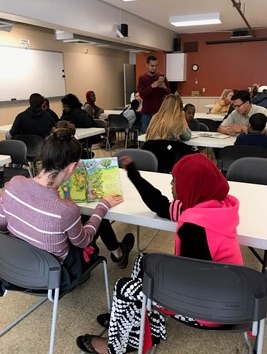How does one find community in a classroom over Zoom and a world that is experienced at a 6-foot distance? At Point Loma Nazarene University, most first-year students receive their course schedule from a counselor a few weeks before classes start, preparing for a whirlwind of back-to-back Zoom calls and virtual assignments. But, what they might not know is some of the general education courses that are necessary to complete, like elementary Spanish, may fall under the category of a community classroom.
Community classrooms provide a learning experience outside the conventional classroom environment and in the San Diego neighborhood of City Heights. Some of these classes include Race & Ethnicity (SOC3060), Elementary Spanish I (SPA1001), Christian Formation & Ministry (CMI1055), Global Christianity (THE3070), Ethics (PHL2011), Literature & Culture – Nature Writing (LIT2000) and Christian Life as Vocation (THE3060).
Jacque Mitchell, a Spanish professor, shared in an email interview that under normal circumstances, “we often work and learn with the children from the Learning Center at the City Heights Town Homes. It’s all refugee children. We also work and learn with the students from Central Elementary School, which is right across the street from our classroom.”
Community classrooms operate out of the Mid-City Nazarene Church and typically students would meet there every week for classes.

This year, community classrooms had to take unconventional forms. On Sept. 29, a group of students taking community classroom courses gathered on Zoom to hear three speakers talk about their experience in the pandemic and how they continue to invest in different San Diego communities. In particular, students learned about the language barriers in City Heights and the setbacks this community’s health centers face in trying to provide healthcare for each citizen.
An employee for a City Heights community health center, who asked to remain anonymous, spoke at this event and explained that as an essential worker operating out of a lower-income and diverse community, they face unprecedented difficulties in delivering health care.
“During this pandemic, we have had to bring barriers down, in particular linguistic barriers,” the employee said. “During COVID-19 times we were providing the care in a safe manner while still educating the community — answering questions and increasing access to make an appointment.”
Seth Veenbaas, a PLNU alumnus, and former student in the community classroom program said community classrooms are the “most successful GE program at PLNU because you’re stepping forth into a real-world setting.”
Veenbass said the experiences and topics covered in the community classrooms extend to “provide opportunities for introspection and a deep look at world view.”
Veenbaas shared that his experience taking an ethics class through the community classroom program fulfilled the regular GE requirements. An added part of the curriculum was community service where they distributed food to the community at the beginning of class.
Likewise, in classes like elementary Spanish, students learn ways they can be involved in the City Heights community. The essential worker from the community dinner said students can contribute to City Heights by “developing educational materials about COVID-19 that are appropriate for each one of the languages and backgrounds of the people that are being served by the health center. It has to be language that helps people understand.”
According to this employee, more than 40 languages are spoken in City Heights.
Additionally, the healthcare worker recommended another opportunity for students to get involved with food pantries or food distribution. With unemployment due to COVID-19, many people in City Heights may depend on food distribution, and students can reach out directly to the human resources at the health centers or visit the websites Feeding America and San Diego Food Bank.
Although this community dinner was confined to a Zoom call, students heard the perspective of an essential health worker and learned how they can make a difference in the greater San Diego community. That is the essence of these community classrooms, according to Veenbaas.
He said, “I think one of the things that stood out to me was speakers that talked about engaging in the community, being less focused on our own individual monetary success in life and viewing success in terms of making the biggest impact in your community.”
Written By: Elaine Alfaro
